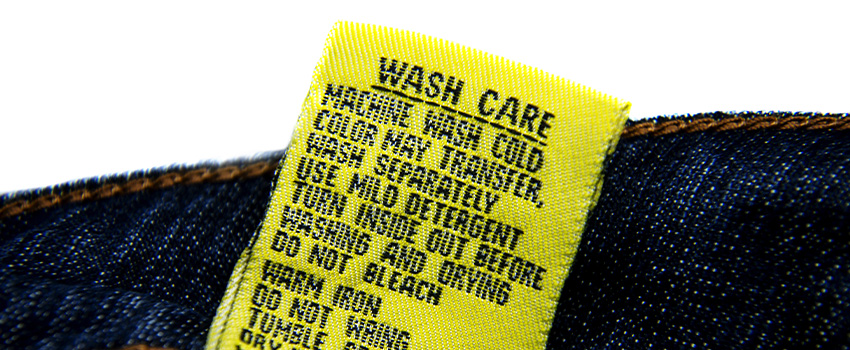Proper care and maintenance of fabrics are very important. Some types of fabrics may require special attention. Lumping everything together will damage your clothes. Although it is tempting to do shortcuts when it comes to laundering, taking the time to do it right is worth the effort. After all, your wardrobe represents a huge investment of money, time, and creativity. Never let carelessness cost you more fortune.
We’ve put together a few guidelines to help you care for your clothes. While you can always check fabric care symbols, following these basic rules of laundering can help you get clean and good-looking clothing after every wash.
Linen
Linen, made from fibers of the flax plant, is often treated with sizing, a finish that makes it crisp. It wrinkles easily and may require ironing.
Dry cleaning is highly recommended to preserve linen colors. You can hand wash or machine wash at your own risk. Linen absorbs more water compared to other fabrics, so do not overcrowd the washer.
Remove any stain immediately using non-bleach products. Bleach can weaken the fibers and destroy dyed clothes.
Always hang your linens to dry. Tumble drying them may cause shrinkage and creases.
Never wash, dry, or iron linens at a temperature exceeding 60 degrees Celsius as fading may occur.
Silk
This natural fiber is one of the world’s oldest clothing material. It is supple, strong, and lustrous. Washing silk requires extra care to prevent tightening or puckering of many weave patterns. Deep dye tones may not be color-fast too.
Check the garment label. It should tell you which design is washable or for dry-clean only. If washable, use gentle products. Hand liquid soap or baby shampoo without conditioning additives are excellent choices.
Do not tumble silk in a dryer. Roll it in a towel to press out water, and then hang to dry.
Cotton
Who does not wear cotton? It is a worldwide favorite because it is versatile and comfortable to wear. Cotton is seen in most garments, from casual shirts to ball gowns!
You must wash cotton fibers using cold water only to prevent shrinkage and preserve deep colors. However, for items that are preshrunk or processed, you can use hot, warm, or cold water, depending on the color and the care label recommendation. If the label agrees, you can use chlorine to clean white cotton.
Dry cotton garments at a lower heat and remove them from the dryer while still fairly cool. Overdrying cotton will cause shrinkage.
Polyester
Polyester makes colorful, durable, and easy to care for garments. You can clean them using a machine with warm water.
Tumble-dry these garments on low heat. Remove them from the dryer while they are still slightly damp to avoid wrinkles and a static buildup. Be careful when ironing polyester. It can melt beneath a scorching iron.
Wool
We all love wool, especially during winter! It is naturally insulating and very easy to dye. In its natural state, wool is washable but you will also find wool garments with complex designs with a “dry-clean only” tag.
If the label requires, wash it using a gentle detergent and lukewarm water. Cold water will shrink the fiber.
Spandex
Spandex is now being used in different types of fabric to add stretch and comfort. While this material is hand or machine-washable, it should not come in contact with hot water and bleach. Both will damage the fibers. Avoid machine drying. Hang the garments to dry. Extreme heat can cause some spandex to bubble. If ironing is necessary, press it quickly.
Cashmere
Take extra care when washing cashmere. This is a sensitive material and can be easily damaged. You can place it inside a laundry or a mesh bag before washing. This will prevent the rapid rotation of the washer from agitating the fabric.
Use gentle or diluted detergent only. Do not tumble dry. Lay out the fabric on flat towels and air dry.
Chiffon
Chiffon is yet another light and delicate fabric. It tends to bleed and fray, thus requiring a lot of care during washing. It is best hand-washed using cold water. For Viscose Chiffon, do not squeeze or twist it as the yarns of the fabric may break easily. On the other hand, you may wash poly Chiffon using a machine.
Acetate
This man-made fiber is often blended with other fabrics to create beautiful, easy-to-drape clothing. Acetate and its blends clean up well but are sensitive to dye transfer. If you are not used to washing this type of fabric, it is best to check the label.
Acetate fibers are best hand-washed in cold water. Its weak fibers can be easily damaged by heat, twisting, or wringing. If you will use a machine, choose a gentle setting.
Acetate can be ironed using a low-heat setting. Use a press cloth to prevent shine and preserve the beauty of the fabric.
At Kelly’s Dry Cleaners, it is our mission to help you keep your clothes clean and soft, just like the way you like them. We offer quality cleaning services without the use of hazardous materials. If you need assistance in caring for your fabrics, you may call our Durango or Farmington offices at (970) 903-1642 or (505) 564-3333, respectively.



